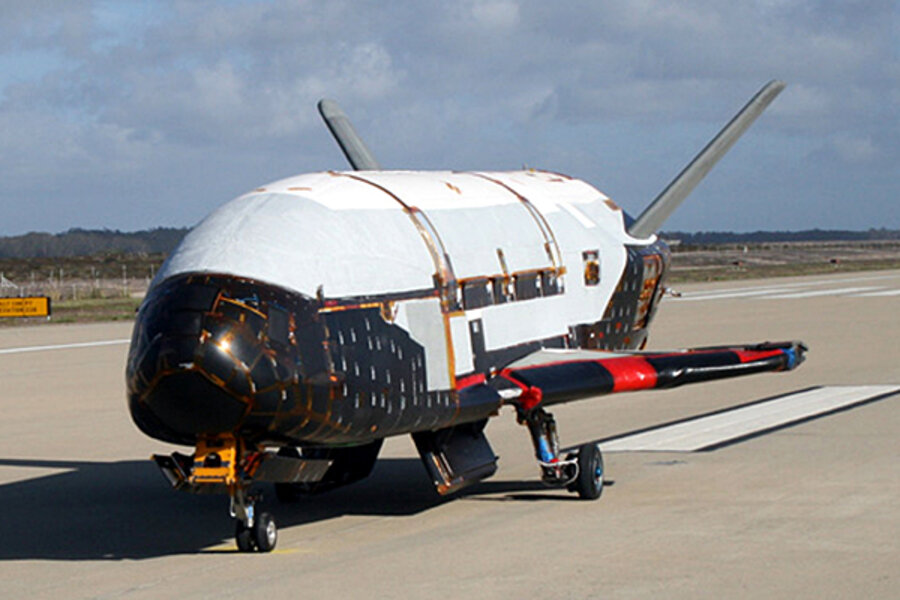Can Russia rival the X-37B space plane with its own robotic spacecraft?
Loading...
| Moscow
Russia's reviving space industry might be working on its own version of the US Air Force's reusable unmanned space plane. After all, Russian space experts seemed surprised, a little alarmed, and possibly in awe of the American X-37B when it was successfully flight-tested from Cape Canaveral Air Force Station on April 22.
The head of Russia's Space Forces, Lt. Gen. Oleg Ostapenko, dropped a tantalizing hint last week that suggested that Russian researchers were working on a similar design.
"Something has been done along these lines, but as to whether we will use it, only time will tell," General Ostapenko was quoted by the official RIA-Novosti agency as saying.
The American X-37B, which spent seven months in orbit doing secret research before returning last December, is a remotely controlled, scaled-down space shuttle-like craft that appears to be dedicated mainly to military tasks.
Most Russian media coverage about the mini-shuttle was dominated by fear. Would the US use the enhanced orbital capabilities the space plane makes possible to undercut Russia's national security? Would the X-37B threaten Russian satellites or even install space-based antimissile weapons?
"The original idea of this space plane was to destroy the enemy's sputniks," says Vladimir Shcherbakov, deputy editor of Vzlyot (Liftoff), a leading Russian aerospace journal.
"It's a kind of space fighter. If your enemy loses all his sputniks – which provide his communication, intelligence, navigation, etc. – he will be in a panic, he'll be helpless. So it's critical, if you're going to build one, that you state what it's for and whom it's directed against," he says. "The Americans haven't declared who their X-37 is to be used against. They just say they're developing new technologies."
Mr. Shcherbakov says it's quite likely that Russia is working on its own space plane, since the Kremlin nowadays identifies successful space projects as key to boosting Russia's international prestige and has spent a lot more money on the once-moribund space industry.
"Nowadays there's more financing, so the search for cutting-edge projects that we can accomplish is going on intensively," he says. "When the Boeing X-37 was tested, it raised questions from the bosses about whether we were building one, too. But this is a secret subject in the US, and even more so here. So no one will tell you for sure."
The once-mighty Soviet space program virtually collapsed during the 1990s, and its only big remaining project is to act as a kind of "space taxi" to ferry astronauts to the International Space Station.
The USSR built a space shuttle, the Buran, which was modeled on the US version, but only managed to test it twice before the program was scrapped in 1993. The surviving copy of the Buran serves as a children's attraction in Moscow's riverside Gorky Park amusement center.
But with growing financial resources, Russian space scientists have a lot more ideas on their drawing boards these days. These include a nuclear-powered spacecraft that could carry cosmonauts to Mars, and a Pac Man-like nuclear powered space pod that could gobble up space garbage and perhaps be used to protect the Earth from asteroid collisions.
A functioning space plane might be useful for the Russians to service the new Glonass satellite network, Russia's answer to the American GPS system, which is still on track to launch this year despite a disastrous crash that cost the program three satellites last December.
Andrei Ionin, an independent space expert, says that Ostapenko's hint about a Russian version of the X-37B is hard to interpret.
"It is the logic of space research that both Russia and the US usually find themselves doing much the same things," he says. "They built a shuttle, we built a shuttle, and so on. But comments like Ostapenko's should be followed by demonstrations and proper official statements. As things stand, who knows what he meant? Perhaps it was just a bit of PR?"





